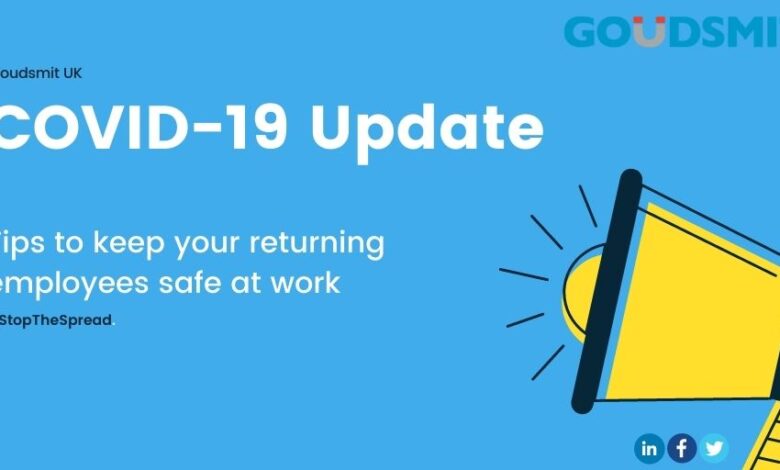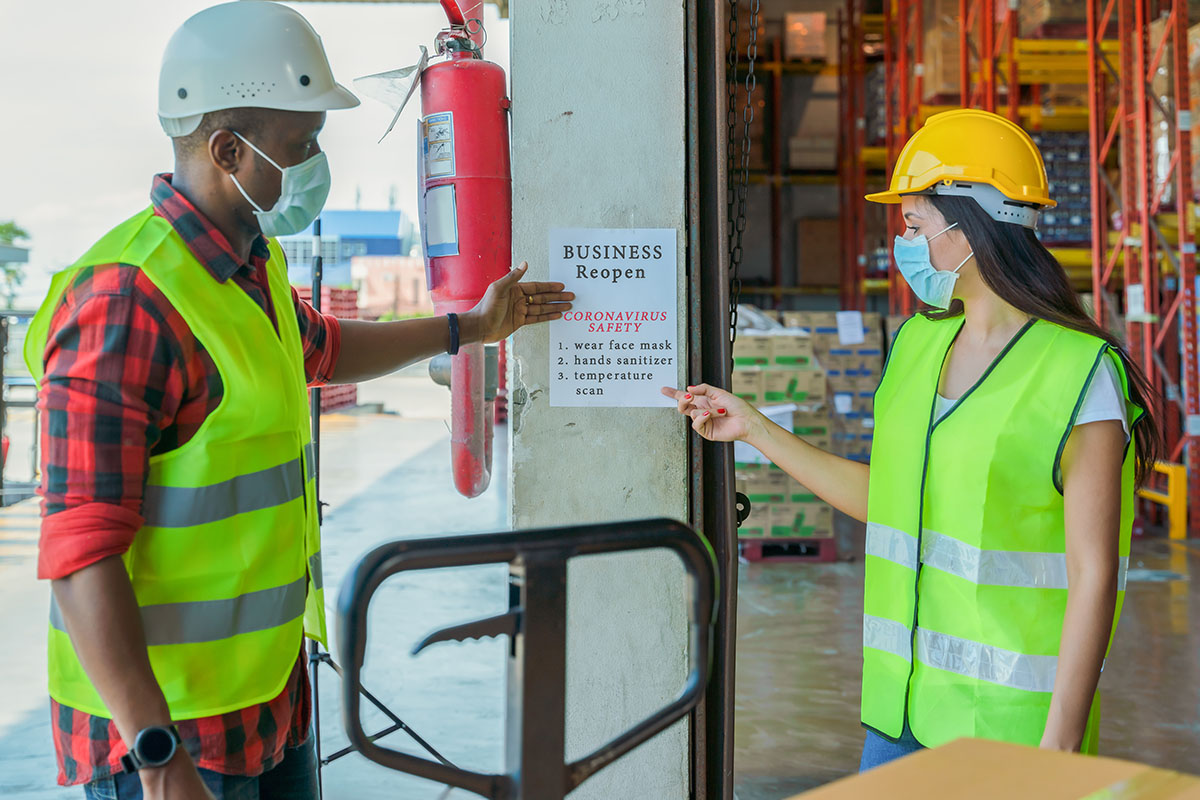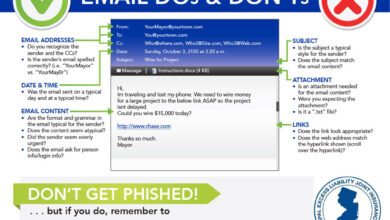
How to Reopen and Keep Employees Safe After Coronavirus
How to reopen and keep employees safe after coronavirus is a crucial issue for businesses navigating the post-pandemic landscape. This guide offers a comprehensive approach to assessing your workplace, implementing safety protocols, training employees, addressing concerns, and maintaining a safe environment. We’ll cover everything from evaluating current health and safety measures to creating a robust communication plan for your team.
A thorough evaluation of your workplace is paramount. This includes identifying potential risks, assessing physical spaces, and soliciting employee feedback. Implementing comprehensive safety protocols, including social distancing, sanitation, and personal protective equipment (PPE), is essential. Training programs, open communication, and a process for handling employee concerns will all contribute to a successful reopening.
Assessing the Workplace

Reopening after a pandemic requires a meticulous assessment of the workplace environment to ensure employee safety and a smooth transition back to normalcy. This phase is crucial for building trust and confidence among staff members, and it’s an opportunity to proactively address potential risks and create a safer, more resilient work environment. A well-structured assessment process, encompassing physical space, protocols, and employee input, is key to a successful reopening.Thorough evaluation of existing health and safety protocols, identification of vulnerabilities, and proactive implementation of COVID-19 safety measures are paramount to a successful reopening.
This is not simply about ticking boxes; it’s about creating a culture of safety and well-being. The focus should be on minimizing risks, while maximizing employee confidence and comfort in returning to the workplace.
Evaluating Current Health and Safety Protocols
A comprehensive review of existing health and safety protocols is essential. This involves scrutinizing policies, procedures, and guidelines to ensure they align with current best practices and public health recommendations. Look for gaps in coverage, areas where the current protocols might not adequately address potential risks, and where modifications are needed to reflect the changing needs of the situation.
For example, a review might uncover outdated handwashing procedures or insufficient provisions for social distancing in high-traffic areas.
Identifying Potential Risks and Vulnerabilities
Identifying potential risks and vulnerabilities is critical. Consider factors such as high-traffic areas, shared equipment, and employee density. This assessment should also account for employee demographics, potential health conditions, and any existing vulnerabilities within the workforce. For example, a workspace with a high density of employees might necessitate more stringent social distancing measures and frequent cleaning schedules. Reviewing previous infection outbreaks or near-miss incidents can provide invaluable insight into potential problem areas.
Assessing the Physical Workspace for COVID-19 Safety Measures
Assessing the physical workspace is essential for identifying areas needing improvement. This includes evaluating the adequacy of air circulation, availability of hand sanitizers, and the suitability of workspace layouts for maintaining social distancing. For example, consider rearranging workstations to ensure adequate space between employees or installing partitions in high-traffic areas. The availability of readily accessible hand sanitizer stations and regular disinfection schedules are also vital aspects to consider.
Importance of Employee Feedback in the Assessment Process
Employee feedback is invaluable in the assessment process. Gather input through surveys, focus groups, or one-on-one conversations to understand employee concerns and suggestions. This will help tailor safety measures to the specific needs and anxieties of the workforce. Active listening and consideration of employee input will build trust and demonstrate that their well-being is a priority. For example, employees might suggest the need for more frequent cleaning of shared equipment or improved ventilation systems.
Checklist for Evaluating Workplace Preparedness for Reopening
A comprehensive checklist is crucial for ensuring a thorough assessment. This checklist should cover all aspects of the workplace, from physical space to policies and procedures. Regular review and updates to this checklist are vital for maintaining the safety of the workplace.
| Category | Criteria | Action Items |
|---|---|---|
| Air Quality | Adequate ventilation, air filtration systems | Ensure sufficient airflow, check air filters, consider HEPA filters |
| Hygiene | Hand sanitizers, cleaning supplies, waste disposal | Place sanitizers at strategic locations, provide cleaning supplies, implement appropriate waste disposal procedures |
| Physical Distancing | Workspace layout, signage | Rearrange workstations for appropriate spacing, post clear signage regarding social distancing |
| Policies | Health protocols, return-to-work guidelines | Review and update existing protocols, develop clear return-to-work guidelines, ensure proper communication |
Implementing Safety Protocols
Reopening after the pandemic requires a proactive approach to employee safety. A comprehensive safety plan is crucial for maintaining a healthy and productive workplace while mitigating the risk of COVID-19 transmission. This plan should encompass every aspect of the work environment, from individual workstations to communal areas. Prioritizing safety demonstrates a commitment to employee well-being and fosters a positive work environment.A well-defined safety plan acts as a roadmap for navigating the complexities of a post-pandemic workplace.
This document Artikels key safety measures, emphasizing the importance of consistent communication, training, and adaptable strategies for maintaining social distancing and sanitation across various work settings.
Sanitation Protocols
Maintaining meticulous sanitation is paramount to mitigating the spread of infectious diseases. Implementing frequent and thorough cleaning and disinfection protocols is essential in preventing the transmission of pathogens. The frequency and method of cleaning should be tailored to the specific use and density of each area. A detailed schedule and clear assignment of responsibilities for each area are vital for successful execution.
- Regular disinfection of high-touch surfaces such as doorknobs, light switches, countertops, and shared equipment is essential.
- Hand sanitizers should be readily available at all entry points, common areas, and workstations.
- Waste disposal systems must be meticulously managed to prevent cross-contamination.
Social Distancing Strategies
Maintaining social distancing is critical for minimizing the risk of transmission. Strategies for maintaining physical separation must be adapted to the specific layout and nature of each work environment. Flexible solutions should be considered for various workspaces to ensure effective distancing.
- Open-plan offices: Employ workstation dividers, strategically place desks further apart, and encourage staggered work schedules or flexible work arrangements to reduce congestion in high-traffic areas.
- Manufacturing facilities: Utilize physical barriers between workstations, implement queuing systems for access to shared resources, and encourage employees to maintain a safe distance when working in close proximity.
- Shared spaces: Designate designated areas for social distancing in break rooms, restrooms, and other common areas. Limit the occupancy of shared spaces and promote the use of individual break rooms where feasible.
Personal Protective Equipment (PPE)
Implementing appropriate PPE can act as a critical layer of protection for employees. The type and use of PPE should be determined based on the specific tasks and potential exposure risks. Training on proper use and disposal procedures is crucial for minimizing risk.
- Masks: Encourage the use of masks in areas where social distancing may be difficult or inconsistent.
- Gloves: Provide gloves for employees handling potentially contaminated materials or equipment.
- Eye protection: Eye protection may be necessary in certain environments with a high risk of splashes or airborne particles.
Communication and Training
Clear communication of safety protocols is vital for successful implementation. Regular training sessions and refresher courses should be provided to reinforce the importance of safety measures and ensure employee understanding.
- Communicate the safety protocols clearly and concisely, using multiple channels (e.g., email, intranet, posters, and meetings).
- Conduct regular training sessions to reinforce safety measures and answer questions.
- Provide employees with access to resources such as FAQs and online guides.
Workplace-Specific Procedures
The following table Artikels specific safety procedures for various workplace areas:
| Area | Procedure | Frequency | Responsibility |
|---|---|---|---|
| Break Rooms | Sanitize surfaces regularly, provide hand sanitizer, limit occupancy | Hourly | Maintenance Staff |
| Work Stations | Maintain 6ft distancing, provide dividers, clean shared equipment regularly | Ongoing | Management/Employees |
| Restrooms | Sanitize frequently touched surfaces, ensure adequate ventilation, limit occupancy | Hourly | Maintenance Staff |
| Meeting Rooms | Limit occupancy, sanitize surfaces between uses, encourage mask use | Ongoing | Management/Employees |
Employee Training and Communication
Reopening after a period of disruption necessitates a proactive approach to employee safety and well-being. Effective training and clear communication are crucial to ensure a smooth transition and maintain a positive work environment. Employees need to understand the new safety protocols and how they apply to their daily tasks. Open communication channels will foster trust and address concerns promptly.
Developing a Comprehensive Training Program, How to reopen and keep employees safe after coronavirus
A well-structured training program is essential for ensuring employees understand and adhere to the new safety protocols. This program should be tailored to different job roles, providing specific instructions relevant to each position. Training materials should be easily accessible and readily available in multiple formats (e.g., video tutorials, written guides, interactive modules) to accommodate diverse learning styles.
- Content Modules: Modules should cover topics such as proper hand hygiene, social distancing practices, personal protective equipment (PPE) usage, and cleaning procedures. Examples of PPE include masks, gloves, and face shields. Real-world demonstrations and simulations can reinforce learning and illustrate best practices. A module could include a step-by-step procedure for cleaning a shared workspace.
- Interactive Sessions: Incorporating interactive elements, such as quizzes and role-playing scenarios, enhances understanding and engagement. These interactive sessions should be held in small groups or online to encourage participation and questions. A simulated scenario of a customer interaction, where appropriate safety protocols are followed, would be beneficial.
- Regular Refreshers: Safety protocols are not a one-time event; refresher training sessions should be scheduled periodically to reinforce learning and ensure compliance. This could involve brief reminders, updates on any changes in procedures, or additional training on new equipment.
Communication Strategies for Transparency
Maintaining open communication is critical during the reopening process. This involves providing clear and consistent information to employees regarding the implemented safety protocols, schedules, and procedures. Transparency fosters trust and reduces anxiety.
- Multiple Communication Channels: Employ various communication channels to reach all employees. These channels could include emails, company intranet updates, newsletters, and regular town hall meetings or virtual forums. These channels should be accessible to all employees, regardless of their location or preferred method of communication.
- Dedicated Q&A Sessions: Establish dedicated Q&A sessions, whether in person or online, to address employee concerns and provide clarification on the reopening plan. Scheduling these sessions at convenient times for various time zones is important.
- Employee Feedback Mechanisms: Implement feedback mechanisms, such as surveys or suggestion boxes, to gather employee input and concerns. Actively listening to and addressing employee feedback will demonstrate the company’s commitment to their well-being.
Key Messaging Points for Safety Procedures
Clearly defining key messaging points for safety procedures will ensure consistent communication and understanding across the workforce.
- Emphasize the Importance of Compliance: The company’s commitment to the safety of its employees must be emphasized. Compliance with the new safety protocols is crucial to ensure a safe and healthy work environment.
- Highlight Benefits of Procedures: Highlight the benefits of following the new safety protocols for individual and collective well-being. Emphasize how these procedures protect employees from potential risks.
- Address Concerns and Misconceptions: Proactively address employee concerns and misconceptions regarding the new safety protocols. Addressing concerns head-on will foster trust and understanding.
Communication Plan for Updates and Q&A Sessions
A detailed communication plan should Artikel the schedule for updates and Q&A sessions, specifying the communication channels and frequency.
| Update Type | Frequency | Communication Channel |
|---|---|---|
| Safety Procedure Updates | Weekly | Company Newsletter, Email |
| New Policy Announcements | As Needed | Company Intranet, Town Hall Meetings |
| Q&A Sessions | Bi-weekly | Virtual Forums, Video Conferences |
Addressing Concerns and Feedback

Reopening after a period of disruption like the coronavirus pandemic requires a delicate balance between safety protocols and employee well-being. Addressing employee concerns and feedback is crucial for fostering a positive and productive work environment while maintaining a safe workplace. Open communication and a willingness to listen are key to building trust and ensuring everyone feels heard and valued.
Handling Employee Concerns and Feedback
Effective communication channels for collecting employee feedback are vital. Establishing multiple avenues for input, such as suggestion boxes, online surveys, and regular meetings, ensures diverse perspectives are heard. Actively seeking input, rather than just passively collecting it, is a crucial component of this approach. This means proactively scheduling meetings, responding promptly to concerns, and showing genuine interest in employee perspectives.
A dedicated team member or department can be assigned to oversee these communication channels and address concerns promptly.
Methods for Active Listening
Actively listening to employee input goes beyond simply hearing their concerns. It involves understanding the underlying reasons behind those concerns and responding with empathy and a willingness to find solutions. This includes creating a safe space for open dialogue, encouraging employees to share their perspectives without fear of judgment, and using non-verbal cues to show attentiveness. Empathetic responses, acknowledging the validity of the concerns, and refraining from interrupting are crucial elements of active listening.
Creating a culture where employees feel comfortable voicing their concerns is essential for long-term success.
Effective Responses to Employee Concerns
Addressing employee concerns requires more than just acknowledging them. It involves crafting thoughtful and actionable responses. This includes promptly addressing safety concerns, outlining the steps being taken to address them, and providing clear explanations for any decisions made. Acknowledging the validity of the concern, even if it doesn’t lead to a change in policy, is crucial to maintaining a sense of trust.
For example, if an employee expresses concern about inadequate hand sanitizer placement, a response might be, “We appreciate your feedback. We’ve already increased the number of hand sanitizer stations in the area and will continue to monitor the supply.” This shows that the concern was heard and addressed, even if the specific request isn’t possible. Demonstrating a commitment to resolving the concern, or at least addressing the underlying issue, is key.
Procedure for Addressing Complaints and Safety Violations
A clear procedure for addressing complaints and safety violations is essential. This procedure should be transparent and easily accessible to all employees. It should Artikel the steps for reporting a violation, the process for investigating the complaint, and the timeline for resolution. This procedure should be clearly communicated, perhaps with posters or a dedicated section on the company intranet.
For example, a documented process for reporting safety concerns through a dedicated email address or a secure online portal can streamline the process. Implementing clear guidelines for handling complaints and violations creates a sense of fairness and accountability.
Obtain access to cima ethics confidentiality rules to private resources that are additional.
Fostering a Culture of Safety and Trust
A culture of safety and trust is built through consistent actions and demonstrable commitment. Regular communication about safety protocols, ongoing training, and a willingness to address concerns transparently all contribute to a safe work environment. For instance, holding regular safety meetings where employees can ask questions and provide feedback, or implementing a system for anonymous feedback, are examples of ways to foster this culture.
This approach fosters an environment where employees feel empowered to speak up about safety concerns without fear of repercussions, thereby improving safety and morale.
Maintaining a Safe Environment: How To Reopen And Keep Employees Safe After Coronavirus
Reopening safely after the coronavirus pandemic requires a proactive and adaptable approach to maintaining a safe work environment. This involves more than just initial safety protocols; it necessitates continuous vigilance, evaluation, and a robust system for responding to new concerns. A focus on ongoing monitoring and proactive adaptation is crucial to fostering a sense of security and trust among employees.
Strategies for Maintaining a Safe Environment
Maintaining a safe environment extends beyond the initial implementation of safety protocols. It demands a proactive approach that anticipates potential issues and adapts to changing circumstances. This includes regular audits, employee feedback mechanisms, and the ability to swiftly respond to emerging concerns.
- Regular Audits and Inspections: Routine inspections of workspaces and equipment are essential for identifying potential hazards and ensuring safety protocols are consistently followed. This involves checking for proper ventilation, social distancing adherence, and the availability of hand sanitizers. Examples of these inspections can include visual checks for cleanliness and proper sanitation procedures. For example, a weekly checklist can be used to identify areas requiring attention and ensure consistent safety measures are followed.
- Employee Feedback Mechanisms: Creating channels for employees to voice concerns and provide feedback is vital. This allows for a direct line of communication between management and employees, allowing them to feel heard and empowered to contribute to a safer workplace. These channels could include suggestion boxes, regular surveys, or dedicated feedback sessions with supervisors.
- Adaptability to Evolving Health Recommendations: Public health guidelines and recommendations can change. It is crucial to stay updated on these changes and adjust safety measures accordingly. This adaptability ensures the workplace remains compliant with the latest guidelines. For instance, if new recommendations emerge regarding ventilation systems, the company must promptly implement the changes.
Ongoing Monitoring and Evaluation of Safety Protocols
Ongoing monitoring and evaluation of safety protocols are not one-time tasks. They are continuous processes that should be integrated into the company’s routine. This includes periodic reviews, analysis of incidents, and employee feedback to improve safety protocols.
- Regular Reviews: Implement a schedule for reviewing and updating safety protocols. This can be done quarterly or as needed, depending on the evolving health situation and any changes in company operations.
- Incident Analysis: When incidents occur, analyze the root cause to identify areas where protocols need improvement. This analysis should not only address the specific incident but also consider any systemic factors that might contribute to similar incidents in the future. For example, if there is a cluster of reported hand-washing incidents, the company must investigate the reason for these incidents.
- Employee Feedback Incorporation: Collect employee feedback regularly through surveys or focus groups. This feedback can provide valuable insights into areas where protocols can be enhanced or adjusted to improve effectiveness.
Reporting and Addressing New Safety Concerns
A clear system for reporting and addressing new safety concerns is essential. This system must be accessible, prompt, and transparent to foster a culture of safety.
- Designated Reporting Channels: Establish clear channels for employees to report safety concerns. This could include a dedicated email address, an online form, or a designated hotline.
- Timely Response and Investigation: Implement a process for promptly investigating and addressing reported concerns. This process should include clear timelines for investigation and resolution, along with transparent communication to affected parties.
- Follow-up and Communication: After investigating a concern, provide a follow-up report and communicate the resolution to the employees involved. This ensures transparency and builds trust in the company’s commitment to safety.
Resources for Additional Information
Providing employees with access to reliable resources for additional information can help them stay informed and engaged in maintaining a safe workplace.
- CDC Guidelines: The Centers for Disease Control and Prevention (CDC) provides valuable information and guidelines on workplace safety. This is a critical resource for up-to-date recommendations.
- Local Health Department Resources: Local health departments often offer guidance and resources tailored to specific communities. Consulting local resources ensures adherence to specific regional guidelines.
- Company Safety Handbook: A dedicated section in the company’s safety handbook can consolidate all relevant information, making it easily accessible for employees.
Conclusive Thoughts

Reopening after the coronavirus requires a proactive and thoughtful approach. By implementing the strategies Artikeld in this guide, businesses can confidently navigate the challenges of the new normal, prioritize employee well-being, and create a safe and productive work environment. Remember that ongoing monitoring, adaptation to evolving guidelines, and a culture of trust and communication are key to long-term success.





